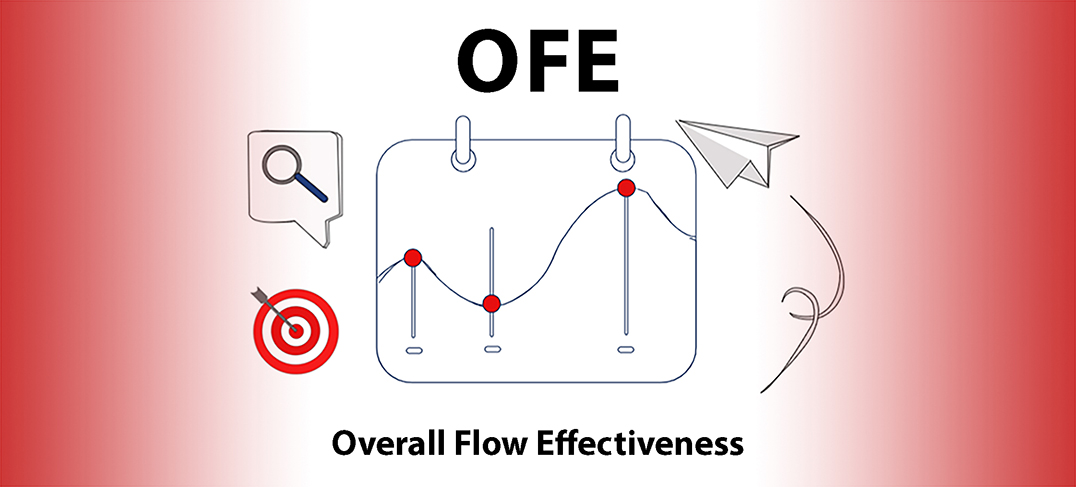Three Phases of Change in Process Improvement
Prepare, Manage, and Sustain are not the only 3 phases of change you need to be aware of. In this article, we are describing the actual detailed...
Category: Uncategorized
Sign in

Overall Flow Effectiveness – OFE
OFE is a Performance Indicator that is meant to put the focus of improvement activities on flow of material. With flow of material we mean flow of products from incoming raw material to shipment of billable products. Focus on flow will lead to an improvement of business targets like:
· Improved On Time Delivery
· Decreased inventory days of supply
· Return on Sales/EBITDA
· Return on Net Assets, RONA
These business KPI’s are the result of the processes and can only be reached by reduction of losses.
Background
Historically businesses have focused on Overall Equipment Effectiveness (OEE and more about OEE later) as a Performance indicator that has a big impact on the business. In part that is correct, however it has led to an unhealthy focus to improve OEE. It’s unhealthy in the way that companies have targeted set up time as one big and easy to attack loss, that has led to bigger batches. Bigger batches of products that sit in house too long and in some cases, are finally obsolete and causes a cost when scrapped.
Running a business where machines are working in a flow to deliver the products means synchronisation of the products must take precedence and the OEE focus disrupts that thought process. The disruption comes from the fact that running a machine with OEE focus makes you chose products that shouldn’t run now and batch size bigger than the customer need. Running a bigger batch, putting several customer orders together or adding a safety stock to the batch, is reducing the number of set ups which gives you more time to produce and your OEE will increase. Doing that also means that you are producing products you can’t sell right now and that will lead to high inventory, low On Time Delivery and a lower financial result.
Definition of Overall Equipment Effectiveness

OEE=Produced parts of correct quality/Theoretical number possible.
A simple way to say this is; If you plan to run for 10 hours and your technical run rate (as fast as the machine can run) is 100 pcs/hour you should have 1000 pcs. If you for example have 650 pcs of the correct quality, you have OEE=650/1000 =65%. There are many reasons why you lost 350 pcs during that time. The reasons are called losses. A loss is basically the difference between the perfect ideal state and reality. Examples of losses are; Set-up time, short stop, breakdown, defects, speed loss etc. If you reduce a loss you will gain time in the machine and produce more parts or the time can be used for other things like setting up to a new order line. This is driven by the actual business need. Do you need more volume or do you need to run more exact to customer demand? All business wants both however at a certain point one is more important than the other.
What will a OFE focus lead to
A focus on OFE leads to a combination of OEE and planning for the customer need.
Definition of OFE
OFE=OEE*GPF
Good Production Factor, is defined as the products you produce that can be sold within a defined time frame. The time frame is set by a good business standard for the respective industry you are in. GPF can be, and should be, changed over time to create a base for continuous improvement.
Good Production Factor – GPF
For example, if your industry standard says that product should be sold within 30 days of completed operation, you can evaluate the percentage number of products that were sold within the time frame.
Example calculation
For a given machine the OEE is 65% and 50% of the products produced are sold within the time frame. OFE calculation gives OFE=OEE*GPF OFE=0.65*0.50 OFE=0,325 =32.5%
If we would reduce the batch size and do an additional set-up we will lose in OEE however we might sell a higher amount of product produced. In this example increased set up reduces OEE with 5% units but gives you a chance to run another order line and increases GPF with 20% units. This is just an example and reality is different.
OFE=0.60*0.7=0.42 OFE=42%
This means that we carry less inventory, deliver more order lines. It costs in OEE but if we still can deliver the volume and don’t have to hire more people to do that, there’s no real cost to it.
A higher OEE can lead to a better OFE as well if the GPF is constant.
If set-up time is reduced by actual improvements to the standard and the time save is used for more set ups to allow more orderliness through it will potentially keep OEE at the same level while improving the GPF. If you reduce other losses like short stops, break downs etc. and OEE goes up a higher volume can be produced and the OFE will be better as well.
If focus on OFE can be done over the whole production line the real output improvements can be tracked.
Johan Majlov, Founder & CEO Lean Dimensions International
[email protected]